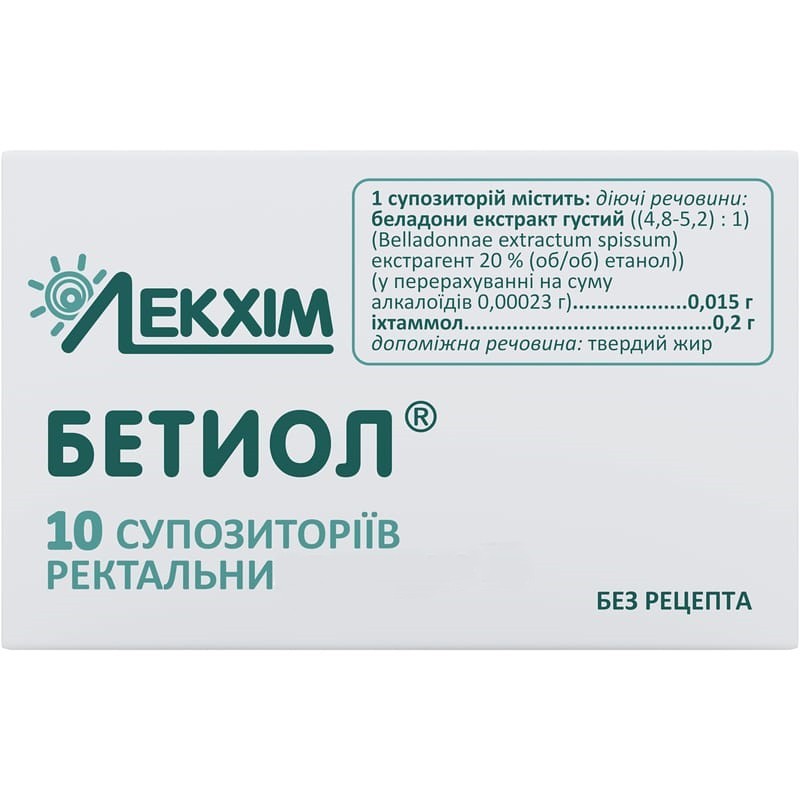



 Secure and encrypted payment processing
Secure and encrypted payment processing We ship to over 40 countries including the USA, UK, Europe, Australia and Japan
We ship to over 40 countries including the USA, UK, Europe, Australia and Japan Guaranteed refund or reship if you haven't received your order
Guaranteed refund or reship if you haven't received your orderActive ingredient: belladonnae extract dense, ichthammol;
1 suppository contains: belladonna thick extract ((4.8–5.2): 1) (Belladonnae extractum spissum) extractant 20% (v / v) ethanol)) (in terms of the amount of alkaloids 0.00023 g) - 0.015 g (15 mg), ichthammol - 0.2 g (200 mg);
excipient: solid fat.
Rectal suppositories.
Basic physical and chemical properties: suppositories of a dark brown color with a characteristic odor of ichthammol, bullet-shaped. The presence of plaque on the surface of the suppository is allowed.
Means for the treatment of hemorrhoids and anal fissures for local use.
Code ATX C05A X03.
Pharmacodynamics
Combined drug for topical treatment of hemorrhoids. It has an analgesic, anti-inflammatory and antispasmodic effect - it weakens the spasm of the intestinal muscles. Belladonna extract has an antispasmodic effect, reduces intestinal motility. Ichtammol has anti-inflammatory and local anesthetic properties.
Pharmacokinetics
There is no data.
Hemorrhoids and anal fissures.
Hypersensitivity to belladonna or to other components of the drug. diseases of the cardiovascular system, in which an increase in heart rate may be undesirable: atrial fibrillation, tachycardia, chronic heart failure, coronary heart disease, mitral stenosis, severe arterial hypertension. glaucoma. urinary retention or tendency to it, prostate adenoma. myasthenia gravis. diseases of the gastrointestinal tract, accompanied by obstruction. hyperthermic syndrome. thyrotoxicosis. acute bleeding.
When used with monoamine oxidase inhibitors, cardiac arrhythmias occur, with quinidine, Novocaineamide - an additive cholinolytic effect is observed. may reduce the duration and depth of action of drugs, weakens the analgesic effect of opiates.
With simultaneous use with diphenhydramine or diprazine, the effect of the drug is enhanced, with nitrates, haloperidol, corticosteroids for systemic use - the likelihood of increased intraocular pressure increases, with sertraline - the depressive effect of both drugs increases, with spironolactone, minoxidil - the effect of spironolactone and minoxidil decreases, with penicillin the effect of both drugs is enhanced, with nizatidine - the effect of nizatidine is enhanced, with ketoconazole - the absorption of ketoconazole decreases, with as withorbic acid and attapulgite - the effect of atropine decreases, with pilocarpine - the effect of pilocarpine in the treatment of glaucoma decreases, with oxprenolone - the antihypertensive effect of the drug decreases. Under the action of octadine, a decrease in the hyposecretory effect of atropine is possible, which weakens the effect of M-cholinomimetics and anticholinesterase agents. With simultaneous use with sulfonamide drugs, the risk of kidney damage increases, with drugs containing potassium, intestinal ulcers may form, with non-steroidal anti-inflammatory drugs, the risk of stomach ulcers and bleeding increases.
The effect of the drug can be enhanced with the simultaneous use of other drugs with an antimuscarinic effect: M-anticholinergics, antiparkinsonian drugs (amantadine), antispasmodics, some antihistamines, drugs of the butyrophenone group, phenothiazines, disiramides, quinidine and tricyclic antidepressants, non-selective neuronal capture inhibitors.
Inhibition of peristalsis by the action of atropine can lead to a change in the absorption of other drugs.
Use with caution in patients with prostatic hypertrophy without urinary tract obstruction; with down disease; with cerebral palsy; liver and kidney failure; reflux esophagitis; hernia of the esophageal opening of the diaphragm, combined with reflux esophagitis, inflammatory bowel diseases, including ulcerative colitis and Crohn’s disease, megacolon; patients with xerostomia; elderly patients or debilitated patients; in chronic lung diseases without reversible obstruction; in chronic lung diseases, accompanied by low production of sputum, which is difficult to separate, especially weakened patients; with autonomic (autonomous) neuropathy, brain damage.
During pregnancy or lactation, the use of the drug is possible only as prescribed by the doctor in the case where the expected benefit for the woman exceeds the potential risk to the fetus / child.
When treating with the drug, it is recommended to refrain from driving vehicles or performing work requiring increased attention and precise coordination.
Adults use rectally 1 suppository 1-3 times a day. the duration of the course of treatment is determined by the doctor individually, taking into account the nature and severity of the disease, the achieved therapeutic effect. as directed by a doctor, it is allowed to use more often.
There are no data on the use of the drug for children.
Symptoms: increased manifestations of adverse reactions, nausea, vomiting, tachycardia, decreased blood pressure, agitation, irritability, tremors, cramps, insomnia, drowsiness, hallucinations, hyperthermia, depression of the central nervous system, suppression of the activity of the respiratory and vasomotor centers, dry mouth, thirst constipation, dilated pupils.
In case of poisoning, delirium develops with psychomotor agitation, requiring special therapy.
Treatment. Parenteral administration of cholinomimetics and anticholinesterase agents. The treatment is symptomatic.
Gastrointestinal disorders: dry mouth, thirst, impaired taste, dysphagia, decreased intestinal motility up to atony, decreased tone of the biliary tract and gall bladder.
From the kidneys and urinary tract: difficulty and delay urination.
Cardiac disorders: palpitations; arrhythmia, including extrasystole; myocardial ischemia.
Vascular disorders: redness of the face, hot flashes.
Neurological disorders: headache, dizziness.
From the side of the organs of vision: dilated pupils, photophobia, accommodation paralysis, increased intraocular pressure.
On the part of the respiratory system and mediastinal organs: a decrease in secretory activity and tone of the bronchi, which leads to the formation of viscous sputum, which coughs hard.
On the part of the skin and subcutaneous tissue: skin rash, urticaria, exfoliative dermatitis, hyperemia.
From the immune system: anaphylactic reactions, anaphylactic shock.
Others: decreased sweating, dry skin, dysarthria.
In these cases, the drug should be discontinued and consult a doctor.
2 years.
Store at a temperature not exceeding 25 ° c.
Keep out of the reach of children.
5 suppositories in a blister, 2 blisters in a pack.
Over the counter.
Private joint-stock company "lekkhim-kharkov".
Ukraine, 61115, Kharkiv region, Kharkiv city, Severin Pototsky street, 36.